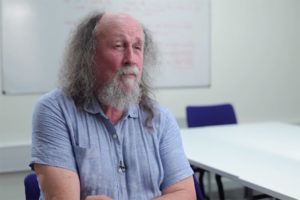Evolutionary Optimality and Plants
Professor of Biosphere and Climate Impacts Iain Colin Prentice on CO2 concentration in nature, photosynthetic ...
The Standard model is a very modest name for what is actually an amazing body of knowledge that explains a huge amount of physical data and the ways the Universe behaves: what the fundamental constituents are, what the fundamental forces or nature are and how they bind together and produce the world around us. So you’d call the Standard model a bit fancier than that but that’s what it’s called. I remember I grew up in Manchester and there was a really-really good Indian restaurant that was called ‘The standard Indian restaurant’ and I think ‘The standard’ meant like the standard which is the big flag that you carry in front of you in an army. I think that’s the way of thinking about the Standard model: it’s the best model as well as that was the best Indian restaurant.
The Standard model is a collection of ideas with some core underlying principles that bind it all together. The core underlying principle is to do with the idea of symmetries and the things that we call ‘gauge symmetries’: I’ll come back to it in a minute. The way it arose was in trying to understand the fundamental forces of nature. In the middle of the 20th century we had Feynman, Schwinger and Tomonaga who put together the first real complete quantum theory of one of the interactions that we have in what we now call the Standard model. That interaction was electromagnetism which is this light, these photons, all that we see, the way charged particles interact. So it was kind of the natural successor of the Maxwell’s equations from many years before. But they made it into a proper quantum theory that was super precise and predictive. That was based on the idea of symmetries.
So people start to say: well, we know there are other forces in nature, we know there’s a weak nuclear force that we were just beginning to get data on and understand, which is involved in radioactive decays, so it’s involved in the fusion reactions in the Sun. Can we use his principles that work so well for electromagnetism to describe these other forces? Throughout the 60s and 70s it gradually became known that there were these other particles that we call hadrons that interact via a strong nuclear force which is the force that keeps the protons and neutrons bound together inside the atomic nucleus. Can we understand the strong force in terms of these symmetry principles?
When you have a good idea you try to use it over and over again, so you try and use this idea of symmetries to describe all the forces. There are two big breakthroughs in doing that and there were some problems. The first problem is that there were so many of hadrons that the way they interactive didn’t seem to match these symmetry principles. That was only really solved in the 70s and 80s when it became clear that hadrons were not fundamental particles, that they were actually made up of quarks. Once you understand that then you can write down a theory of how quacks stick together, what the fundamental strong force between quarks is (it’s carried by a particle called a gluon) and that became part of the Standard model that we call quantum chromodynamics. In the same way that electrons have electrical charge you have to invent another kind of charge with a strong force: they call it color. There’s no particular reason for it except that we might use words that are not too unfamiliar even for forces and ideas that can be very unfamiliar sometimes.
So there is a symmetry behind the strong interaction, this QCD, chromodynamics, which in some ways is similar to the symmetries behind the photons but it’s still a different symmetry. For instance, there are gluons which are like photons and there are the differences connected to the fact that quarks can never be free on their own. Electron can be free on its own, but because of the nature of the strong force a quark can never be. And that was worked out over decades, in the 60s, 70s, 80s and beyond, still in the 90s, we are still understanding this, how the strong nuclear force works.
I skipped over the other fundamental force in the Standard model which is the weak force. The reason is that, on the one hand, the weak force should be easier than the strong force to understand, because we know that it interacts with the electrons and muons and we can see that, we didn’t have to wait until we discovered quarks to work out what was going on. On the other hand, it threw out really tricky problems in terms of the mathematics of that force, and people were mislead a few times by thinking the pions were the fundamental particles involved in that.
But in the end we understand that there is a symmetry behind that force as well. The unique thing about that force is that the particles that carry out the force have mass. There’s a couple of ways to think about it, one idea is that it only interacts with left handed particles and not right handed ones. But that business with the mass was a bit of a row block. It mixes in with the electromagnetic force in a way that is not so clear either. In the end to solve that issue of how you can have the W± and Z bosons. They are the equivalent of a photon: the electromagnetic forces are carried out by a photon, strong nuclear forces are carried out by the gluons both of which are massless, but the weak forces are carried out by the W± and Z-bosons both of which have mass. Incorporating that mass into theory is very tricky and that led to kind of the final postulated particle in the Standard model which is the Higgs boson which is what allows, first of all the W± and the Z, but actually in the end all the fundamental particles to have mass. The Higgs boson is kind of the manifestation of the background energy field in the Universe, and by interacting with it the W± and the Z and the other particles get that mass.
In the end you have a picture (to which he have arrived at this torturous route but quite quickly) of a Standard model which is based on three forces: electromagnetic force, the weak force and the strong force. There are six kinds of matter particle: there’s an electron and a neutrino that goes with it which has no electric charge. Then there’s the up quark in the down quark. From those you can build the rest of the matter, because two ups and a down quarks will make you a proton, two downs and an up will make you a neutron and if you have protons and neutrons you can make all the atomic nuclei. If you then have an electron as well you can make all the atoms and all the chemistry and everything that we see around us.
But for weird reasons that we don’t really understand nature has copied that again. So there’s another heavier version of the electron called a muon and it has a neutrino, and there is the charm and the strange quark as well. And then again there’s another heavier version which is called the tau-lepton and its neutrino and a top quark and a bottom quark. You’ve got these three generations with four particles in each and those interact by exchanging the bosons. The electromagnetic force interacts with everything that has electrical charge, so that’s everything except the neutrinos. Everything interacts with the weak force although all of them very weakly, and only the quarks experience the strong force. Underlying that and allowing them to have mass there’s the Higgs boson.
With that set up there’s quite a lot of arbitrary parameters in that the things we don’t know. Why are there three generations? Why are the masses what they are? Why is the top so super-heavy and the neutrino is so superlight? We don’t really understand all of those things, but nevertheless: you’ve got those six quarks, six leptons that are the electron and the neutrinos etc and three forces based on symmetry principles. With that you can explain all the data that we see in our particle colliders, you can explain the whole of the periodic table in chemistry and therefore the biology. That’s quite a big deal for something that we call ‘The Standard model’.
The Higgs boson was that the last thing predicted by the Standard model that was discovered relatively recently, in 2012. But as I say, it’s not to say that there are no open questions about the Standard model. Now that we’ve actually discovered the Higgs boson we know that the Standard model in principle can predict things at really high energies, but there are some really weird things that can happen when it does that, we don’t fully understand it. It’s actually very hard to calculate some things with the Standard model even though in principle it could predict everything. For instance, in strong forces we don’t really know how to calculate all the masses of the hadrons: we can calculate some, some progress being made, but it’s quite difficult. So you have a basic theory but if you follow all the consequences of the theory through to understand all the phenomena that comes from it, with the strong force that’s quite a challenge, with all the forces as we go to higher energies that can be a real challenge. There are this interesting calculations, all challenges and techniques in physics to be done there.
There are also things about the Standard model that seem a bit arbitrary, they kind of hint on its underlying structure. If you think about the periodic table of atoms, the structure of that table is part of the genius when put together, because it’s the big clue as to how the atoms are made. There are similarities in the behavior in each column and the elements get gradually heavier as you go down. That’s kind of reminiscent of what I just described in the Standard model: you have the electron and its neutrino, the up quark and the down quark and then everything in the same way gets heavier. Maybe that’s sensing that these are not really fundamental, maybe like the atoms they’re made of something else. Maybe there’s some underlying principle that means that there has to be three copies and they have to have masses that increase, we don’t know. The Standard model is so subtle in some ways and complex that it might even be built into the Standard model in ways that we don’t fully understand or it might mean (more likely probably) that there’s more physics beyond the Standard model that we don’t yet understand.
I mentioned briefly the fact that the weak force only interacts with left-handed particles. What I mean by left and right hand is that they have a spin, so if the directions of spin and motion are opposite you say it’s left handed particle and if the direction of its spin is the same as the direction of its motion it’s the other way around. Depending on which way the spin is pointing compared to its direction than you call it left or right handed. There’s property called chirality in particles which is very closely related to that spin, the handidness, for massless particles it’s the same thing. We know that weak interaction only interacts with the left-handed particles and the right-handed antiparticles and we don’t know why. Is there another version of the weak forces even weaker that can interact with the other ones? We just don’t know.
I just mentioned anti particles, I never really even mentioned them all the way through, but in the Standard model all these particles also have antiparticle versions of them. The electron has an antiparticle version called the positron which has got positive charge and the electron has negative charge. Likewise there is anti up quark and anti down quark, which you can make an anti proton with, they’re making anti hydrogen atom at CERN at the moment with antiparticles of proton and electron.
So antimatter exists. What we don’t understand is why there isn’t more of it because you would imagine that in the Big Bang may be equal amounts of matter and anti matter because that’s what happens in our particles collisions. But in that case where did all this antimatter go? There’s no anti matter in the Universe around us. Now we can make it but as far as we can tell there are no planets and galaxies made of antimatter. So that’s another mystery: we know the antimatter is there but we don’t know why there isn’t more of it, that’s weird.
I guess maybe the final thing to say is that for a long time in the Standard model we thought the neutrinos, those mysterious particles that only interact by the weak force, we thought that they were massless. We know now that they’re not, they have masses, but they are very tiny. That’s another mystery: why they should be not zero but so tiny? But the other thing is connected with antimatter: antimatter is like matter but all the charges are inversed. By charges I mean not just the electric charge but also the color charge under the strong force and the weak force charge as well. They’re all inverted. If you think about the neutrino, it doesn’t interact with the strong force, it has zero strong force charge, that isn’t inverted. It has no electric charge, so that doesn’t change. And actually the right handed neutrino doesn’t interact with the weak force either. The weak force interacts only with the left handed particles.
So the neutrino actually could be an antiparticle because you flip all the charges, but all charges are zero, so minus zero is the same as zero. So that’s a kind of puzzle: does this particle even really exist, this right handed neutrino that doesn’t interact with any other forces? Or we know it exists, if they have mass it implies that it has to exist, but we don’t know whether it’s really an antiparticle, does it go with a mass in some special way. It feels like a very special and unusual particle in the Standard model that doesn’t interact with any of the forces of the Standard model. That’s another thing people are actively looking for in rare decays where we might learn more about that and whether this neutrino is an antiparticle.

Professor of Biosphere and Climate Impacts Iain Colin Prentice on CO2 concentration in nature, photosynthetic ...

Epidemiologist Nick Wareham on the discovery of insulin, clinical diagnostic tests for diabetes, and the thrif...

MIT Senior Research Scientist Frank Taylor on two types of current interactions, experiments with predictive p...